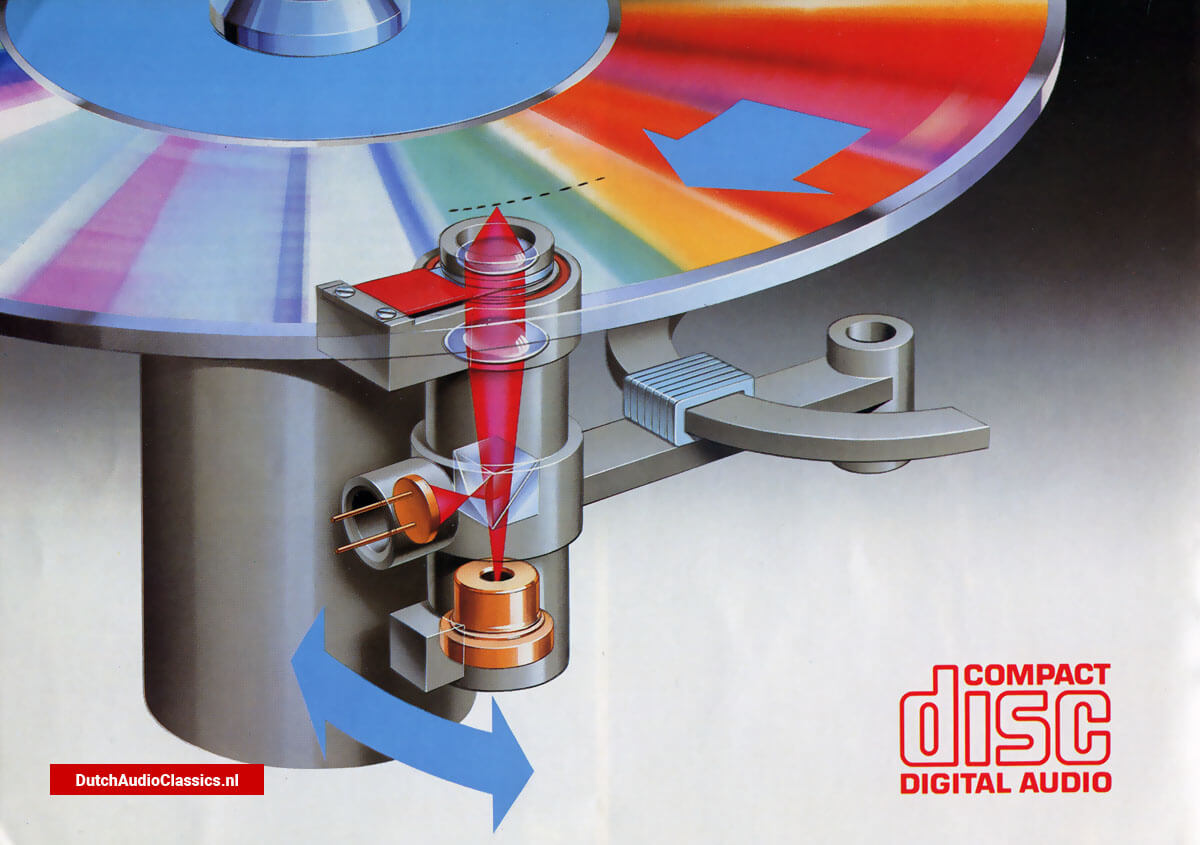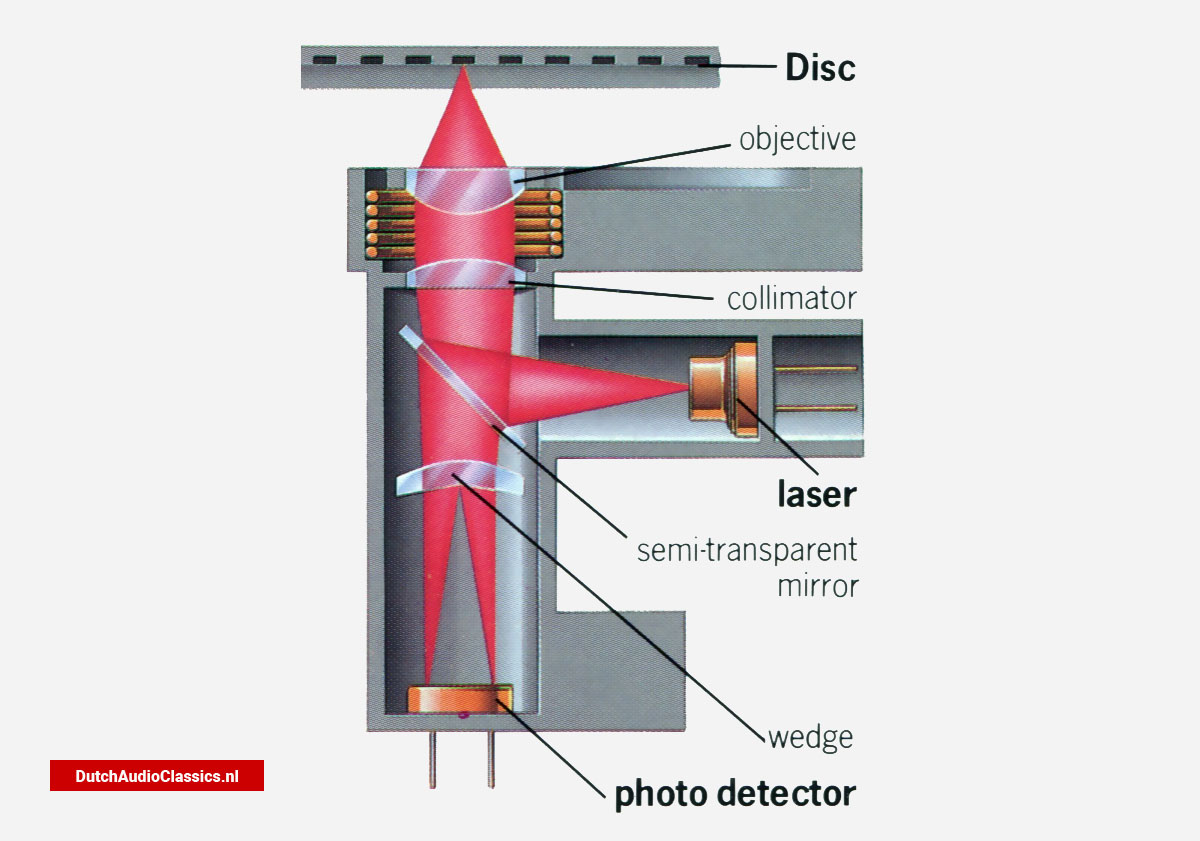Compact Disc Digital Audio is a totally new sound source: fully digital, and astonishingly accurate. From the master recording right through the stereo signal that feeds the audio amplifier — nothing is added, nothing is taken away.

From the lowest frequencies to the highest levels, the sound that is heard is an exact copy of the sound that was recorderd; no detectable noise, no measurable wow and flutter. Dynamic range is exceptional, frequency response is mirrorflat, and overall channel separation and phase linearity are extremely good.
The Digital recording is sealed inside the shining silver disc — safe from scratches, fingerprints and dirt. The pick-up is a laser beam. It could not wear out a disc if it ran for a hundred years.
Special modulation (EFM) and error correction (CIRC) systems optimise the signal handling and further suppress the effects of marks and scratches
The CD 101 connects directly to any sound installation with a line input (CD/TV, Aux, Tape or Tuner). It will bring the very best out of any installation. but the better the system, the bigger the advantage gained.
High-stability digital-to-analogue conversion for true 16-bit performance.
The digital-to-analogue converter is a 16-bit unit with digital oversampling filter, noise shaper, D/A chip, and simple analogue filter.
Laser pick-up with non-polarising, inter¬ference-free beam.
Automatic electronic focussing and track following, and wear-free no-contact track scanning. Quality optical components lead to maximum simplicity in the beam direction system — and more tolerance for disc imperfections.
Digital filtering.
The audio signal filtering —on which sound quality ultimately depends —is digital. For more precise, stable and compact than an equivalent analogue filter.
Soft muting
Soft muting ensures increased concealment of drop-outs and smoother switching of operating controls.
Single stage servo tracking
Single stage servo tracking keeps the laser beam exactly on track by automatic adjustment of one single control variable. Cutting out complexity to maximise precision and reliability.
High components integration
Electronic circuit and player functions, integrated to the highest degree of modern solid-state technology, use the minimum of discrete components and interconnections. This means consistent performance and highest reliability.
Direct drive motor servo
The servo-controlled direct drive motor synchronises disc rotation to the data pattern on the disc itself.
State-of-the-art semiconductor laser
Long-life ambient temperature semiconductor laser with infra-red beam. Absolutely safe in operation with very low power output, wideangle focus. completely enclosed (under disc) beam, and power interruption when the disc compartment door is opened.
The optical readout
Apart from digitalisation, Compact Disc Digital Audio introduces another very significant innovation — optical read-out using a laser beam. In essence, a laser is a source of highly concentrated light which can be very sharply focused. The word 'Laser', in fact, stands for Light Amplification by Stimulated Emission of Radiation, and because of the precise nature of the beam, the laser princ¬iple has already found many applications in science and industry.
The Compact Disc laser, a small, low-power semi-conductor (aluminium gallium arsenide) unit, emits invisible infra-red light.
 The CD Laser Beam Pick-up: one milliwatt of power is all that is needed by the tiny light beam. Yet it reads every last detail of the digital information on the disc.
The CD Laser Beam Pick-up: one milliwatt of power is all that is needed by the tiny light beam. Yet it reads every last detail of the digital information on the disc.
The Compact Disc optical read-out system achieves a read-out accuracy, from an extremely high-density digital recording, that no mechanical system could ever hope to attain.
Dust particles and scratches sit on the disc surface, out of the focus of the laser beam. Because the beam is highly convergent, most particles and scratches are small in relation to the spot diameter
Philips CD Optical Readout System
The beam from the laser is reflected by a special semi-reflecting mirror to the lens system, which keeps it in sharp focus on the recording in the Compact Disc. Beam reflections returning through the lens system pass straight through the semi-reflecting mirror, and on to the photo-detector.
An optical system concentrates the laser beam to a spot less than 1 micron (pm) in diameter, capable of reading the densely packed recording in the Compact Disc. This recording consists of a contin¬uous track of pits in a brightly reflective surface. The pits are microscopic - only 0.5 pm wide, 0.1 pm deep and 1 to 3 pm long, at a track pitch of 1.6 pm.
As the disc rotates, the laser scans the pit pattern. When the beam falls on a flat surface, it is reflected. The optical system guides the reflected beam to an array of photodiodes. When the beam falls into a pit, it is scattered. Very little light finds its way through to the photo-diode array. The flats and pits on the recorded track are thus read as 'on' and 'off' impulses by the photodiode array. The sequence of impulses forms the data stream of channel bits for the player electronics.
The beam reads the recording from the inside to the outside of the disc. A servo system holds the spot in focus on the recording surface, compensating for disc warp or any other unevenness in disc rotation. A second servo compensates for eccentricity and holds the beam on the track. This tracking servo is also used to move the beam across tracks, to gain fast access to any part of the recording, and to create pauses in the music.
Tracking and Focusing: choosing the best method
Player performance depends heavily on effective tracking and focusing. Eccentricity may swing the rotating disc up to 300 pm from side to side, but the spot should follow the centre of the track within 0.1 pm. Disc warp may be as much as 1 mm, but the spot should focus on the track within 0.5 pm. The spot should also stay in position in spite of shock, vibration or dropouts. But it needs to cross tracks quickly for track skip or music search. These are tough require¬ments. But the Philips CMD 2 Laser Assembly, with its control servos, meets them all.
Single-spot or 3-spot Beam?
A single-spot beam can be mounted on a pivoted arm or a linear tracking sledge. Philips use a pivoted arm, which moves very fast for track access, and is highly sensitive to tracking corrections.
The traditional disadvantages of the pivoted arm do not apply to a laser beam pick-up, with its electronic servos. A 3-spot beam must be mounted on a linear tracking sledge, which may compromise the fast access and tracking sensitivity. At the same time, the secondary spots are vulnerable to inter¬ference from adjacent tracks, which can affect tracking and focusing.
For tracking, Philips players use a single-spot laser on a low-inertia pivoted arm, in preference to a 3-spot laser on a linear tracking sledge. The pivoted arm, with linear magnetic drive, moves faster (less than a second from inner to outer track). It follows large ecce.itricities easily, withstands bumps well, and, with only one moving part, is reliable and long-wearing. Mechanically isolated by fully floating suspension, it is practically immune to shock and vibration.
 The beam from the laser passes straight through a special semi-reflecting prism and on to the lens system, which keeps it in sharp focus on the recording in the Compact Disc. Beam reflections return through the lens system to the semi-reflecting prism, where they are diverted away from the laser and into the photo-detector.
The beam from the laser passes straight through a special semi-reflecting prism and on to the lens system, which keeps it in sharp focus on the recording in the Compact Disc. Beam reflections return through the lens system to the semi-reflecting prism, where they are diverted away from the laser and into the photo-detector.
Because the read-out is optical, the 'pick-up' causes no more wear to the recording than reading causes to the words printed on this page. In fact, the reflective track surface is covered with a transparent plastic seal, which affords permanent protection. The very high opening angle of the objective lens keeps surface scratches, dust and dirt well out of focus, and only really large marks are detected by the photo diodes. Even then, the CIRC error correction system increas¬es the capability to cope with severe optical distortion arising from dirt or damage.
The Compact Disc system
- From the Compact Disc system originators — the most advanced player design
- Pure, Perfect Sound — Forever
- Direct access to any music track
- Maximum ease of operation
- Convenient multimode programming
- No disc wear, and no microphone because of laser technology
- Midi component or free-standing model
- Connects directly to any HiFi system
Specifications
Playback System: Compact Disc Digital Audio
Frequency range: 20 Hz - 20 kHz, ± 0.3 dB
Phase linearity: + 0.5°
Signal-to-noise ration: > 90 dB
Channel separation: > 90 dB (at 1 kHz)
T.H.D. (incl noise): < 0.005%
T.H.D. (incl noise): < 0.004% (at 1 kHz)
Intermodulation distortion: < —86 dB (at max. output level)
Out-band rejection: (frequencies > 24 kHz) > 50 dB
Wow and flutter: Quartz control precision
Optical read-out system
Laser type : Semiconductor Al Ga As
Numerical aperture : 0.45
Wave length : 800 mm
Output
Max. output level (at MSB): 2 V RMS, typical
Output impedance: < 100
Minimum load impedance: 10 k
Power supply
Mains voltages: 220 V AC, with service solution for 110, 127 and 240 V
Mains frequencies: 50 and 60 Hz
Power consumption : 20 W approx.
Electrical requirements : IEC
Cabinet, general
Material/finish: Polystyrene, with extruded aluminium profile
Dimensions (w x h x d): 320 x 73 x 267 mm
Connection cable with moulded Cinch plugs
Weight: 5 kg approx.



























